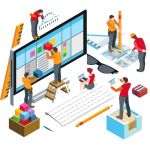Our service portfolio covers an entire software
development life cycle and meets varied business needs.

Technologies
Our expertise spans all major technologies and platforms, and advances to innovative technology trends.

Dev Ops & Cloud Services
At the core of our services is the goal to listen, learn, collaborate, plan, advise and then to provide the right set of technology tools available which make business better.
The word DevOps is a combination of the terms development and operations, meant to represent a collaborative or shared approach to the tasks performed by a company’s application development and IT operations teams. DevOps is the most modern approach in the realm of software development. The name itself clearly signifies a medley of two terms – Development and Operations.With this approach, software development and operations go hand-in-hand. From writing initial code to final delivery, the entire workflow gets streamlined.
We strive to deliver state-of-the-art DevOps services & solutions to business for automating and streamlining the processes in a cross-functional environment. DevOps empower developers, operations team, test engineers, product managers and executives to collaborate closely with each other for enhanced transparency and agility. By leveraging continuous integration and delivery, it helps enterprises to cater to the emerging market needs more rapidly and efficiently.
IaaS (Infrastructure-as-a-Service), PaaS (Platform-as-a-Service) , and SaaS (Software-as-a-Service) are the three most common models of cloud services
SaaS—also known as cloud-based software or cloud applications—is application software that’s hosted in the cloud and that you access and use via a web browser, a dedicated desktop client, or an API that integrates with your desktop or mobile operating system. In most cases, SaaS users pay a monthly or annual subscription fee; some may offer ‘pay-as-you-go’ pricing based on your actual usage.
In addition to the cost savings, time-to-value, and scalability benefits of cloud, SaaS offers the following:
SaaS is the primary delivery model for most commercial software today—there are hundreds of thousands of SaaS solutions available, from the most focused industry and departmental applications, to powerful enterprise software database and AI (artificial intelligence) software.
PaaS provides software developers with on-demand platform—hardware, complete software stack, infrastructure, and even development tools—for running, developing, and managing applications without the cost, complexity, and inflexibility of maintaining that platform on-premises.
With PaaS, the cloud provider hosts everything—servers, networks, storage, operating system software, middleware, databases—at their data center. Developers simply pick from a menu to ‘spin up’ servers and environments they need to run, build, test, deploy, maintain, update, and scale applications.
IaaS provides on-demand access to fundamental computing resources–physical and virtual servers, networking, and storage—over the internet on a pay-as-you-go basis. IaaS enables end users to scale and shrink resources on an as-needed basis, reducing the need for high, up-front capital expenditures or unnecessary on-premises or ‘owned’ infrastructure and for overbuying resources to accommodate periodic spikes in usage.
In contrast to SaaS and PaaS (and even newer PaaS computing models such as containers and serverless), IaaS provides the users with the lowest-level control of computing resources in the cloud.
IaaS was the most popular cloud computing model when it emerged in the early 2010s. While it remains the cloud model for many types of workloads, use of SaaS and PaaS is growing at a much faster rate.
Experience Design
Web & App Development
Cyber Security
Internet of Things
Devops Cloud Services
